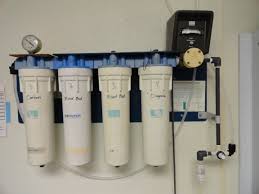Your water purification system is composed of filters, carbon blocks, and advanced resins used to remove specific contaminants. Manufacturers can choose from various technologies, including activated carbon, electro-positively charged depth filter media, and reverse osmosis. The choice depends on the type of contaminants they want to target and the intended purification method. Here are a few types of technology used in water purification units and systems:
Filtering Technologies
Purifying water usually involves filters, membranes, or matrices that prevent specific contaminants from passing through. You can find a water purification system that uses a custom-blended inner core of carbon block or activated carbon filters. Other systems feature special advanced resins, sediment filters, ceramic filters, and ultrafiltration. Activated carbon filters remove chlorine, pesticides, lead, arsenic, volatile organic compounds, herbicides, mercury, PFAS, and cadmium. They also help improve water odor, color, and taste.
Sediment filters remove dirt, sand, rust, and other large particles, while ceramic filters use tiny pores to block bacteria and sediments. Absorption filters absorb chlorine and sediments, and ultrafiltration uses membranes with small pores to remove bacteria and dissolve organic matter. Ultrafiltration still allows water minerals to pass through the membrane.
Water purification units may feature multiple steps, each providing unique filters and membranes targeting different contaminants. Examples include thermally bonded microglass, cellulose, and nano-alumina fibers. Nano-alumina fibers reduce hardness, organic matter, and some salts. Filtration technologies physically separate the impurities from water, while membrane technologies use semi-permeable membranes to trap contaminants. Industrial systems may use reverse osmosis, which involves forcing water through a membrane to remove salts, heavy metals, and microorganisms. Whole-house water purification units usually use composite filters to remove impurities. They also use adsorption materials like activated alumina to attract and trap contaminants like fluoride and arsenic.
Softening Technologies
Water softening is part of purification since hard water can lead to scales and corrosion of plumbing infrastructure. Hard water also causes stains and spots, hair and skin issues, and soap and detergent inefficiencies. Water softening technologies help remove hard minerals like calcium, magnesium, silica, phosphates, and sulfates. Leading purification systems reduce the effect of calcium and magnesium on your systems. You can also find saltless conditioners that address both positively and negatively charged substances. Water softening technologies include ion exchange, magnetic field, deionization, reverse osmosis, and lime.
Ion exchange water purifying systems involve the use of salts. Salt-based softeners replace the calcium and magnesium ions with sodium ions to reduce hardness. Breakthrough magnetic field technology is used for certain home systems because it helps reverse hard water conditions without electricity or salt. Eliminating the use of salt allows you to maintain a balanced pH and preserve minerals like magnesium and calcium. Deionization is another option that involves removing all mineral ions, resulting in ultra-pure water. The technology strips water of iron, manganese, radium, arsenic, heavy metals, hydrogen sulfide, and other contaminants, improving odor and color. Some purifiers use nucleation-assisted crystallization to transform magnesium and calcium into micro-crystals. The micro-crystals don’t stick to surfaces, so you won’t have a scale problem.
Find Quality Water Purification System Today
Water purification involves removing unwanted impurities while preserving minerals in residential or commercial systems. You can find systems with multiple technologies to address heavy metals, bacteria and viruses, sediments, and chemicals. Leading systems combine filters, adsorbers, catalysts, and alkalizers to address a wide range of contaminants. Search for an expert installation specialist, as they will be able to help you find the right unit size for your needs and assist with installation and maintenance. Speak to a water purification system supplier today to learn more about the different options and technologies available.

